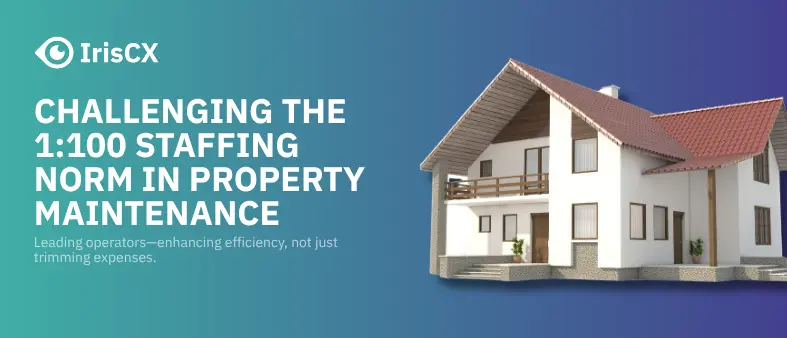Meeting Maintenance Demand: Shaping Supply to Match the Need
A Personal Introduction to Maintenance Demand
I started my career as a maintenance consultant. Back then, I was new to systems and knew even less about maintenance. But a mentor gave me a framework that transformed my perspective: “Maintenance is a demand engine that drives supply.”
It’s a deceptively simple idea. In property operations, demand is created every time something needs to be fixed, inspected, or prepared—turnovers, routine requests, upgrades. Supply is everything used to meet that need: labor, tools, parts, and vendors. When these don’t align—whether due to timing, capacity, or communication—systems break down.
And in today’s environment, that alignment is under more strain than ever.
The New Reality: Doing More With Less
Across the industry, maintenance teams are being asked to deliver more value with fewer resources. It’s not just a staffing issue—it’s a structural shift. Labor shortages, rising wages, and increased resident expectations have created a perfect storm. Getting the job done isn’t just harder—it’s emerging as a risk factor.
Vacant units that can’t be turned in time impact occupancy and cash flow. Delayed maintenance leads to resident dissatisfaction and increased turnover. Every unresolved work order is both a service gap and a financial liability.
This is why the push for efficiency isn’t about cost-cutting—it’s about survival and performance. When done right, improving maintenance processes not only reduces operational stress but also drives Net Operating Income (NOI). The stakes are high, and the margin for error is shrinking.
Maintenance in the Field: What Demand Really Looks Like
In most communities, maintenance is designed around fast response. A resident files a request. A technician is dispatched. Often, the first trip is diagnostic. The second is the fix. Similarly, when a resident gives notice, staff may initiate a formal make-ready or just coordinate vendor work. These are all examples of demand being generated.
Yet the reactive model comes at a cost. While Service Level Agreements (SLAs) for simple repairs might promise 24–48 hours, the average age of a work order can exceed two weeks. What’s behind that gap? It’s not laziness or lack of urgency—it’s a mismatch between the volume of demand and the capacity of supply.
Stress Testing the 1:100 Technician Model
Let’s explore the math behind one of property management’s most quoted benchmarks: one technician for every 100 units.
Imagine a 300-unit property with 50% annual turnover:
- 150 unit turns per year, each taking ~16 hours → 2,400 hours of labor
- 6 work orders per unit annually → 1,800 work orders
- Each work order takes 2 trips at 45 minutes → 2,700 hours of labor
That totals 5,100 hours of labor annually. With each technician providing roughly 1,750 productive hours per year, the workload equals 2.9 technicians—right in line with the 1:100 model.
But here’s what the model doesn’t account for:
- Seasonal spikes in turnover
- Equipment failures during extreme weather
- Absences, training, or non-billable meetings
- The time it takes to context-switch between tasks
- Parts To be Ordered
- Approvals
- Open Job Positions (lack of supply).
The result? Even the best teams fall behind. Deferred tasks pile up, burnout creeps in, and the operational risk grows.
Reshaping Demand to Reduce Strain
Rather than overextending supply, what if we could reshape the demand?
Here’s how targeted strategies can shift the balance:
- Increase retention by 10% → 30 fewer turns annually → Saves 480 labor hours
- Reduce work orders from 6 to 4 per unit → Saves 600 work orders → At 2 trips per order, that’s ~900 hours saved
- Improve first-time fix rate (reduce from 2 trips to 1.1) → Eliminates ~600 additional hours
In total, these changes free up ~2000 hours—essentially an entire technician’s annual capacity. But more than just saving hours, these interventions improve workflow consistency and responsiveness. They create a more aerodynamic operation: smoother, faster, and designed for performance, not just firefighting.
Centralization and the Risk-Reward Balance
In this environment, centralization is often proposed as a solution. And it can be—when implemented with nuance.
The core challenge is this: demand and supply are traditionally bundled on-site. But today’s operational demands require us to decouple what must be done physically from what can be handled remotely or automatically.
Ask:
- What tasks can be centralized? Scheduling, triage, diagnostics, communication follow-ups
- What must remain on-site? Physical repairs, inspections, emergency interventions
- What can be automated? Preventive maintenance alerts, supply reordering, routine updates
This approach doesn’t eliminate jobs—it optimizes roles. It allows highly skilled technicians to focus on the tasks that truly require their presence and expertise.
The Link to NOI: Maintenance as a Financial Lever
Too often, maintenance is seen purely as a cost center. But in truth, it’s a major driver of NOI:
- Faster turns → higher occupancy
- Fewer service delays → better resident satisfaction and retention
- Less reactive work → lower overtime and emergency costs
- Streamlined operations → reduced waste, better vendor utilization
In a market where margins are tight and capital is constrained, improving maintenance outcomes can yield material gains to asset performance. For owners and operators alike, this is a strategic imperative—not a back-office tweak.
From Rule of Thumb to Rule of Design
The 1:100 staffing ratio isn’t wrong—it’s just incomplete. It was built for a world that assumed smooth demand, abundant labor, and stable expectations. That’s no longer the world we operate in.
Instead, we need a new framework. One that starts with:
- Understanding the shape of your demand
- Designing your supply chain and staffing to match it
- Applying technology and process design to optimize the intersection
This is no longer about “doing more with less” as a slogan—it’s a design challenge with real operational and financial consequences.
Getting the job done isn’t optional—it’s mission-critical. But getting it done smartly, with demand-informed systems and supply-aware processes, is what separates high-performing operators from the rest.




